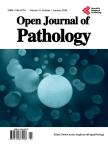Kikuchi-Fujimoto Disease Associated to the Epstein-Barr Virus. A Type of Rare Necrotizing Lymphadenitis and Its Differential Diagnosis
Kikuchi-Fujimoto Disease Associated to the Epstein-Barr Virus. A Type of Rare Necrotizing Lymphadenitis and Its Differential Diagnosis作者机构:Unidad de Patología Hospital General de México “Dr. Eduardo Liceaga” México D.F. México
出 版 物:《Open Journal of Pathology》 (病理学期刊(英文))
年 卷 期:2013年第3卷第4期
页 面:186-192页
学科分类:1002[医学-临床医学] 100214[医学-肿瘤学] 10[医学]
主 题:Kikuchi-Fujimoto Disease Epstein Barr Virus
摘 要:Introduction: Kikuchi-Fujimoto disease (KFD), also known as histiocytic necrotizing lymphadenitis, is a specific and self-limited disease;its etiology is unknown. Some causal microorganisms have been proposed. The objective of the present article is to emphasize the clinicopathological characteristics of this disease that has been associated to the Epstein-Barr virus and to compare the histological changes with other types of necrotizing lymphadenopathies. Material and Methods: We studied 32 patients of the Surgical Pathology Service with necrotizing lymphadenitis, diagnosed in the years from 2004 to 2012 to found more cases of this rare disease in our Institution. Patients were 18 women and 14 men with an average age of 37 years. Results: The lymph nodes were cervical and axillary ones, some were associated to autoimmune diseases and no cause was identified in others. One of the cases, was diagnosed as KFD, presented morphological changes characteristic of this disease, such as subcapsular lymphoid follicles, zones with cell debris, epithelioid macrophages, clear-cytoplasm histiocytes, and immunoblast-reactive lymphocytes. Immunohistochemical markers were determined, such as CD20, CD2, CD4, CD8, CD68, lysozyme, CD56, granzyme B and EBER, which demonstrated the presence of B, T lymphocytes, histiocytes and cells positive to EBER. Histological changes in KFD occurred in three stages: proliferative stage, necrotizing, and xanthomatous. It is important to identify the histological stages of the disease because a differential diagnosis must be performed in regard to lymphadenopathies with necrosis and diverse types of lymphomas. Conclusion: We present a case of necrotizing lymphadenitis (KFD) associated to the Epstein-Barr virus and in some cases it is not possible to render a specific diagnosis based on morphologic findings, alone, and a diagnosis of necrotizing lymphadenitis may be used.



